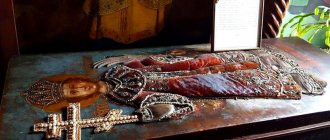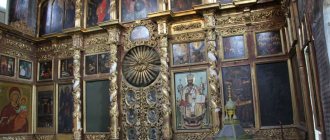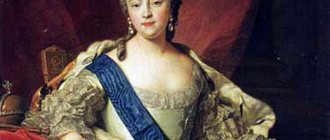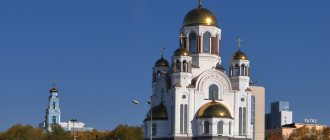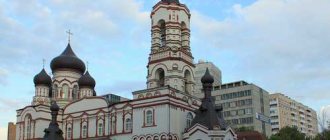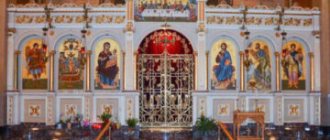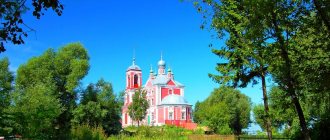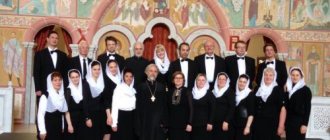The Church of Tsarevich Dimitri “on the Blood” is one of the most sacred and memorable places in the ancient city of Uglich - on the high Volga bank, near a river bend, erected in memory of events in the history of the country that were both tragic and fateful. They began with the death of the youngest son of Tsar Ivan the Terrible on May 15, 1591, which to this day remains not only a sad, but never fully clarified page in Russian history.
The Church of Tsarevich Dimitri “on the Blood” , standing on Rostovskaya Uglich Street, already by its name indicates its historical location: it is believed that his altar was installed exactly where the tragic bloodshed and death of the youth took place.
Tsarevich Dmitry was the last of the heirs of Tsar Ivan IV the Terrible, and therefore his death under mysterious circumstances gave rise to many versions and rumors, many of which are reflected in the chronicles of that time. Despite the conclusion of the special commission that investigated the tragedy, popular rumor stubbornly dismissed the accident, explaining the death of the prince as a planned murder in the interests of the pretender to the throne. This version was shared by many scientists and cultural figures, including Alexander Pushkin.
Miraculous signs
Today, the Church of Tsarevich Dimitri “on the Blood” is perhaps the most famous and popular attraction of Uglich. It is visited every year by a huge number of pilgrims and tourists; fortunately, this shrine is everywhere mentioned in reference books on Volga travel and guides to the Golden Ring of Russia.
Bogomoltsev is attracted to the Kremlin garden by the place itself: it was here, in the backyard of the princely palace, that the august youth died. And in 1606, after the prince was canonized, a wooden chapel was erected here, which a quarter of a century later, by royal decree, was replaced by a beautiful wooden tent church.
The circumstances of the construction of the chapel on the site of the death of the heir to the throne are significant in themselves. According to a long-standing urban legend, in the summer of 1606 the Highest decision was made to transport the relics of Tsarevich Dmitry from Uglich to the capital city. The funeral procession went towards the Moscow road, but at the moment when the special stretcher found itself in front of the St. John the Theologian Monastery, it suddenly stopped of its own accord. After which they seemed to “froze”, so that the porters could not even move them from their place.
Then it was decided to change the route, and the solemn procession set off towards the Rostov road. This time no miracles happened, but at the exit from the then city boundaries, the sad procession stopped again in order to provide the opportunity to say goodbye to the prince to the numerous townspeople of Uglich who accompanied him. An open-air service was organized, which lasted the whole day.
It was during the Divine Liturgy that pilgrims began to notice that a trickle of blood began to ooze from the coffin of Tsarevich Dmitry, placed in a stretcher. This amazing event, in no way possible 15 years after the death of the youth, was recognized as a sign from above, and it was decided to immediately lay the foundation of the temple - “on blood.” Its predecessor was a wooden chapel.
Its life was short-lived: already in 1611 the chapel burned down during the Polish-Lithuanian devastation of Uglich, which was accompanied by disastrous city fires. Later its building was restored.
Walking around the Kremlin
This place is amazing and unusual: the Uglich Kremlin. Everything here is so steeped in history and unexpectedly “diluted” with modern colors.
Nearby there is a pier where excursion ships regularly arrive to disembark the next batch of tourists.
Along the Volga there are many souvenir shops offering a variety of national products. Foreigners willingly buy it all.
Here you can easily take a photo with the “kings” who walk side by side along the embankment. Or you can dress up yourself in the costume of a queen or noblewoman to feel like a part of Russian history, at least for a few minutes.
So come, come! Plunge into the clear expanse of the beautiful Volga and the history of our Motherland. Its turns and zigzags are no less impressive than the natural curves of the Volga. It is very interesting and very beautiful here! And if you remember the events that took place here, it’s truly breathtaking!
Wooden Church of Tsarevich Dimitri “on the Blood”
The first sovereign of the Romanov dynasty, Tsar Mikhail Fedorovich, in 1630 issued a decree according to which a large wooden church was to be erected at the site of the death of the young Tsarevich Dmitry, where a chapel had previously been erected. Its building was of a tent type.
According to some information, at the main altar, consecrated in the name of the holy youth, there was also a warm church dedicated to Michael the Archangel. In the main altar of the temple there was a tomb built over the place where, according to legend, Dmitry’s blood was once shed. Church chronicles note that every year on the day of the prince’s death, drops of his blood appeared from the sand. Among the eyewitnesses of this miracle was Emperor Alexei Mikhailovich, who visited Uglich in 1663.
History has not preserved more information about the external appearance or interior decoration of the wooden building of this memorial temple, and at the end of the 17th century its walls completely dilapidated.
Museum – Princely Chambers
The building of the Chambers of Appanage Princes is the oldest building in the Uglich Kremlin. Their construction dates back to 1480.
They are only a small part of the palace of Prince Andrei the Bolshoi that once stood here and are famous for the fact that the youngest son of Ivan the Terrible, Tsarevich Dmitry, lived there, who was killed here.
To the left of the entrance there is a monument to an innocently murdered youth who died on May 15, 1591.
During the attack by the Poles, the palace was burned, but the chambers were miraculously preserved.
And there is another legend about this building. They say that when the cathedral was being built nearby, they wanted to dismantle the residential chambers into bricks. But some force did not allow me to do this. As soon as a person climbed up the porch to begin the analysis, something incredible immediately pushed him down. Frightened by these events, the workers decided to stop trying and leave the Chambers alone.
Also, according to rumors, there is a secret underground passage that leads to the other side of the Volga, and countless treasures are hidden there. But there is no confirmation of this.
The state chambers are a hall located on the third floor of the building, decorated with paintings. This large hall is accessed via a luxuriously decorated covered staircase. Now the building on 3 floors houses various exhibitions dedicated to the history of Uglich.
Here are collections of various antique clothing and household items,
weapons and church utensils.
Stone temple of Tsarevich Dimitri “on the blood”
There are different versions regarding the timing of the start of construction of the new stone temple of Tsarevich Demetrius “on the blood”. It is known that its wooden predecessor was dismantled at the behest of Tsars Peter and Ivan Alekseevich, who then reigned jointly in Russia. The stone construction of the building, which still exists today, began on this site in the period 1681-1683. The work was completed in 1692, although there is an opinion among historians that the temple could have been built over the course of 15 years.
As a result, the new stone church became the second of the buildings of the then Uglich Kremlin. In the same 1692 it was consecrated. The stone building of the new House of God was decorated in the colorful style of Moscow architecture of that time.
Over the next century and a half, no major repair or restoration work was carried out in the church building, and services were held here regularly.
The main innovation that the 19th century brought to the architecture of the temple ensemble of the Church of Tsarevich Demetrius “on the Blood” was a new chapel in its northern part.
In 1867, the interior of the lower tier of the temple was significantly updated: a large iconostasis, decorated with carvings and covered with gilding, was installed there.
Today, the interiors of this magnificent church are one of its main attractions.
The history of the Temple of Tsarevich Dimitri “on the Blood”
The history of the Church of Tsarevich Demetrius “on the Blood” is different from the fate of many other Orthodox churches in Uglich. It was the only city church that was not closed on charges of “counter-revolutionary propaganda” during the years of Soviet power. The reason for this was its new incarnation: the building became part of the Uglich Kremlin Museum.
The pre-revolutionary era was a time of prosperity for the temple of Tsarevich Demetrius “on the blood.”
In 1892, the Uglich Kremlin was given the status of the Museum of Antiquities and from now on this applied to the entire architectural ensemble. Now entire museum exhibitions have begun to find residence in the Church “on the Blood,” many of which still exist to this day.
The museum of the city of Uglich is rightfully considered one of the oldest not only in the district, but throughout Russia. On this occasion, grandiose celebrations were organized, largely due to the arrival of high officials of the imperial court.
From the first days, the new institution was called the “Museum of Domestic Antiquities.” A special committee was in charge of the museum. Already in the year of opening, the first and very voluminous “highlight of the program” appeared - the exiled bell that had returned from Tobolsk. Nowadays it is presented in the interiors of the Church of Tsarevich Demetrius “on the Blood”.
How Uglich came to be
It was here, in ancient times, that the Uglich Kremlin was located - the first city fortification, which gave rise to the city of Uglich. It was located in a place convenient for defense, fortified with earthen ramparts and wooden walls, which were destroyed and restored many times.
The Uglich Kremlin is one of the oldest in Russia. It was first mentioned in chronicles in the 10th century! Over time, a city formed around the fortress.
At the beginning of the 17th century its population was 45 thousand people. There were 186 churches and 12 monasteries in Uglich. Under False Dmitry, the city was completely destroyed and burned. The self-proclaimed ruler did not need witnesses to the murder of the rightful heir, Tsarevich Dmitry. As a result, about 500 people survived in the city.
The restoration of the city took place under the new tsar: Mikhail Fedorovich Romanov.
During the time of Catherine II, the Kremlin wall became very dilapidated. There was no direct threat of attack on Uglich by enemy nations at that time. Therefore, by order of the empress, the fortress wall was dismantled. And none of the subjects dared to ask about the restoration of the new defensive structure. This is how the Kremlin was left without a protective wall.
After the revolution
In the early 1920s, the Bolshevik authorities of Uglich decided to create anti-religious exhibitions in several churches in the city. Therefore, the Resurrection Cathedral and the Smolensk Church of the Epiphany Monastery (1923) were officially transferred to the museum’s disposal, and a year later, the Kremlin Church of Tsarevich Dimitri “on the Blood” (1924), located next to the museum. Four years later, the neighboring Spaso-Preobrazhensky Cathedral joined it.
The museum's funds were systematically replenished, largely due to objects seized from various churches, as well as from estates that had not yet been plundered. In the 1920s, many icons, church utensils and decorations, textiles and sewing, ancient Russian paintings and wooden sculptures came from the churches and monasteries of Uglich.
When the Great Patriotic War began, the preservation of the museum fund became a priority. Therefore, in 1941, the most valuable exhibits, made of gold and other precious metals, were hastily evacuated to the city of Galich.
In the 1970s, Yaroslavl specialists from the local research and production restoration workshop worked in Uglich. The colorful paintings on the walls of the Church on the Blood were cleaned and strengthened.
In the early 2000s, cracks appeared on the facades of the temple, especially behind the altar, so urgent restoration of the building was required. The danger has been eliminated.
On December 24, 2004, the Historical and Art Museum of the city was transformed into the Uglich State Historical, Architectural and Art Museum. Together with him, the fate of the Church of Tsarevich Demetrius “on the Blood” continues, in the history of which many more interesting facts and discoveries await.
Inside the Temple of Tsarevich Dimitri “on the Blood”
The interior decoration of the temple looks both modest and cozy. Here there are many historical relics associated with the fate of the prince, such as an exiled bell, a stretcher and a shrine for transferring the relics of the youth to Moscow, as well as a mica lamp that illuminated the path of this sad procession.
The undoubted attraction of the building’s interior is the unique door of the refectory, which has been preserved since the construction of the temple. It is colorfully painted and skillfully decorated with openwork rivets made of forged metal.
Among the witnesses to the birth of this church, many images have been preserved in its iconostasis. One of them, installed in the refectory, dates back to the 17th century, while the temple iconostasis was made approximately in 1867, stylized in the Baroque era and covered with carvings and gilding. Both iconostases contain bright images by masters of the Moscow State Armory Chamber, the best Russian isographers of their time.
The greatest impression when visiting this temple is left by its wall paintings.
The themes of the Last Judgment and the “Miracle of the Khonsky Monastery” are devoted to the themes of the painting of the vestibule of the building, created in the 18th century. Immediately near the entrance to the temple, visitors are greeted by a full-length image of the prince-youth. Further, behind the ancient door, in the refectory you can see a mural from 1788.
Between the windows of the first and second light there are frescoes on the theme of the prayer “Symbol of Faith”; above them are depictions of famous Russian saints.
The large-scale composition “The Murder of Tsarevich Dimitri” also attracts attention, reflecting precisely the “Uglich” version of the murder of the prince, in contrast to the “Moscow” one, which is based on an accident. The paintings actually illustrate the entire Uglich tragedy. The events of May 1591 develop in them sequentially, from left to right.
Shrines[edit]
2016 marks the 205th anniversary of one of the revered shrines - the icon of the holy martyr John the Warrior. The image was donated to the temple by the Uglich merchant Mikhail Alexandrovich Khorkhorin.
It is also the 205th anniversary of the temple icon of Tsarevich Demetrius, painted in 1811 by Uglich craftsmen for this church. It is known that she participated in all religious processions throughout the city of Uglich, held on the Feast of the Intercession of the Mother of God.
At the right choir there is a shrine with a particle of the relics of Tsarevich Dimitri and a shroud.
Here is the ark with the relics of the Holy Prince Roman of Uglich. He was the third Uglich prince and on the princely throne he was elevated by virtues and piety to the rank of locally revered saints.
The relics were found in 1495. In 1595 there was his general glorification. In 1611, during the Polish-Lithuanian intervention, the relics suffered from a fire and, along a luminous pillar above them, were recovered from the ashes a second time. Since 1930 they were in the Uglich Museum, and in 1989 they were transferred to the church.
At the left choir there is a reliquary with the relics of the infant martyr John (Chepolosov), killed on May 25 (June 8), 1663. He showed a high confession of love for God and parents, refusing to study magic, for which he suffered cruel torture from his fanatic teacher. Soon the relics were miraculously recovered and glorified by the church commission. Already his parents, who were building a temple on the grave of their son, prayed to him.
In the small iconostasis of the chapel of Kirik and Iulitta there is a miraculous image of the Intercession of the Most Holy Theotokos, brought from the Intercession Monastery, which was devastated in 1930.
According to legend, the icon sailed on the water and stopped in front of the monastery. Monk Bogolep, a baker, came to the shore for water and when he saw the image he announced it to the brethren. The icon was taken out of the water and placed in the temple. She immediately showed herself with many miracles and healings. A cathedral was built in honor of the icon and the monastery began to be called Pokrovsky. Processions of the cross were held with this icon every year.
Here are also the revered icon of the Mother of God “Unexpected Joy”, the Myrrh-Streaming Icon “Tikhvin”, the revealed icon of the Korsun Mother of God from the source of the village of Stana and the Athos image of St. Nicholas.
At the exit is a temple icon of the Uglich Saints, painted in 1951 for the 150th anniversary of the temple with the blessing of the rector of the temple, Hieromonk Nikodim (Rotov), later Metropolitan and prominent hierarch of the Russian Orthodox Church.
The local clergy rests in the temple graveyard, at whose graves pilgrims pray.
